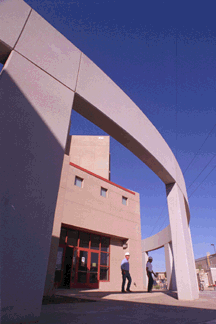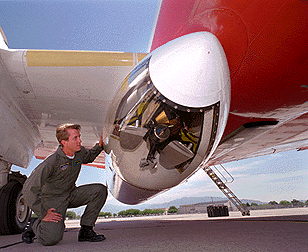ALBUQUERQUE, N.M. — The Cold War has ended, but the threat posed by weapons of mass destruction remains.

In order to address that threat, Sandia National Laboratories, a Department of Energy multiprogram science and engineering laboratory, has constructed a new ultrasecure 85,000-square-foot facility that will tackle the complex challenges of national security. In essence, the goal of the new Center for National Security and Arms Control (CNSAC) is to wage peace.
The center is doing that by developing technologies to monitor arms-control agreements; developing security systems to ensure nuclear materials do not fall into the hands of terrorists or aggressive states; creating satellite systems to detect and characterize manufacturing emissions associated with nuclear, chemical or biological weapons; sponsoring scientific collaborations with nuclear weapon scientists in the former Soviet Union and redirecting their weapons technologies to commercially viable non-weapon products; and building trust and confidence among nations and agencies throughout the world.

“The work being done at the center is bringing Sandia’s enormous technical and scientific skills, once dedicated to winning the Cold War, to developing new arms control monitoring and verification technologies,” says DOE Secretary Federico Pena. “This center will be the focus of a worldwide movement toward greater openness, accessibility and mutual cooperation. The center really is revolutionary and visionary.”
Adds Roger Hagengruber, Sandia’s vice president for National Security Programs, “As we stand on the threshold of the 21st century, we can see we won’t be fighting a cold war, but the gains we have made have to be preserved. There’s always a risk in making peace. Unless you’ve subdued the other guy totally, you must be constantly vigilant, never letting down your guard, or the peace will prove to be short-lived and just an interlude to the resumption of war.”
A building dedication ceremony on August 28 showcased many of CNSAC’s technologies, and also highlighted Sandia’s rich heritage as a weapons and national security Department of Energy laboratory.
CNSAC is home to four elements of Sandia’s National Security program:
- The Systems Analysis team keeps abreast of national defense policies and evaluates the effects that new technologies have on the deployment, vulnerability, and use of nuclear weapons systems.
- The Advanced Concepts group investigates new and conventional technologies and proposed countermeasures to potential threats.
- The Systems Assessment team assesses foreign technologies and supports DOE efforts to identify threats to U.S. national security.
- The Remote Monitoring and Verification group supports international arms-control treaties by designing, engineering, producing, and fielding monitoring instruments and by advising the U.S. government on verification needs.
CNSAC’s primary goals include:
- Implementing new sensor technologies to verify that no nuclear detonations occur in the atmosphere, underwater, or underground anywhere in the world. This includes seismic technologies, which detect and characterize underwater and underground explosions.
- Developing technologies to monitor nuclear materials and weapons to ensure these materials do not fall into the hands of terrorists or aggressor states.
- Developing satellite systems to detect and characterize telltale manufacturing emissions associated with nuclear, chemical, or biological weapons.
- Developing Sandia’s capability to produce high-resolution, 3-D images of objects on the ground, using aircraft-mounted devices that direct electromagnetic energy to the ground and receive its reflected echoes. These images provide a more complete look at potential proliferation activities.
- Sponsoring scientific collaborations with nuclear weapon scientists of the former Soviet Union and redirecting their weapons technologies to commercially viable non-weapon products.
- Building trust and confidence among nations and agencies throughout the world through Sandia’s Cooperative Monitoring Center.
Sandia is a multiprogram Department of Energy laboratory operated by a subsidiary of Lockheed Martin Corp. With main facilities in Albuquerque and Livermore, Calif., Sandia has broad-based research and development programs contributing to national security, energy and environmental technologies, and economic competitiveness.